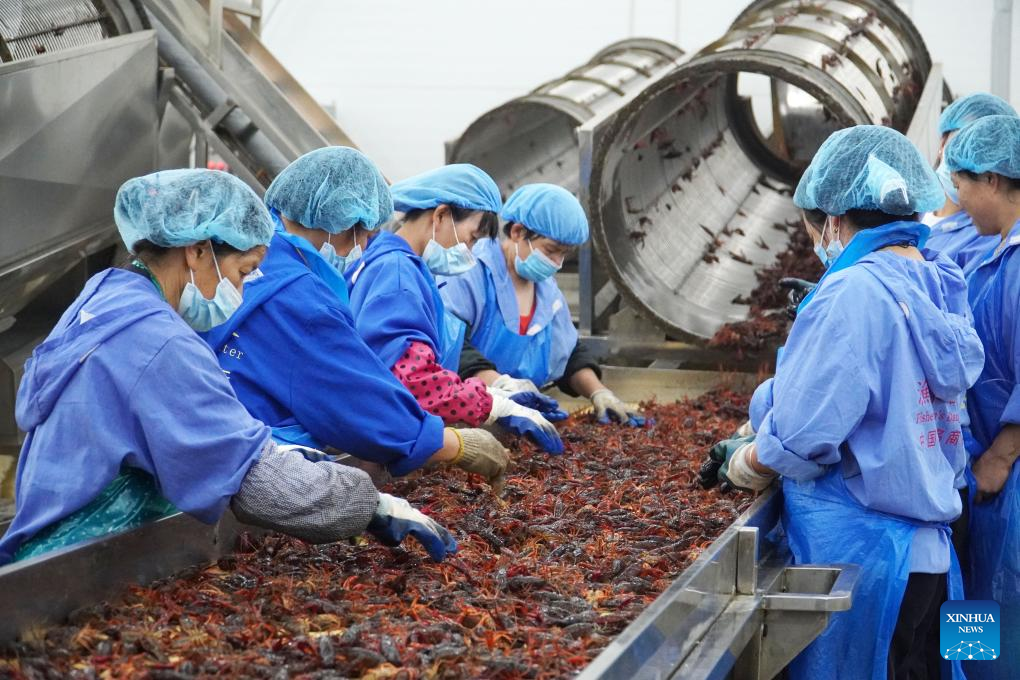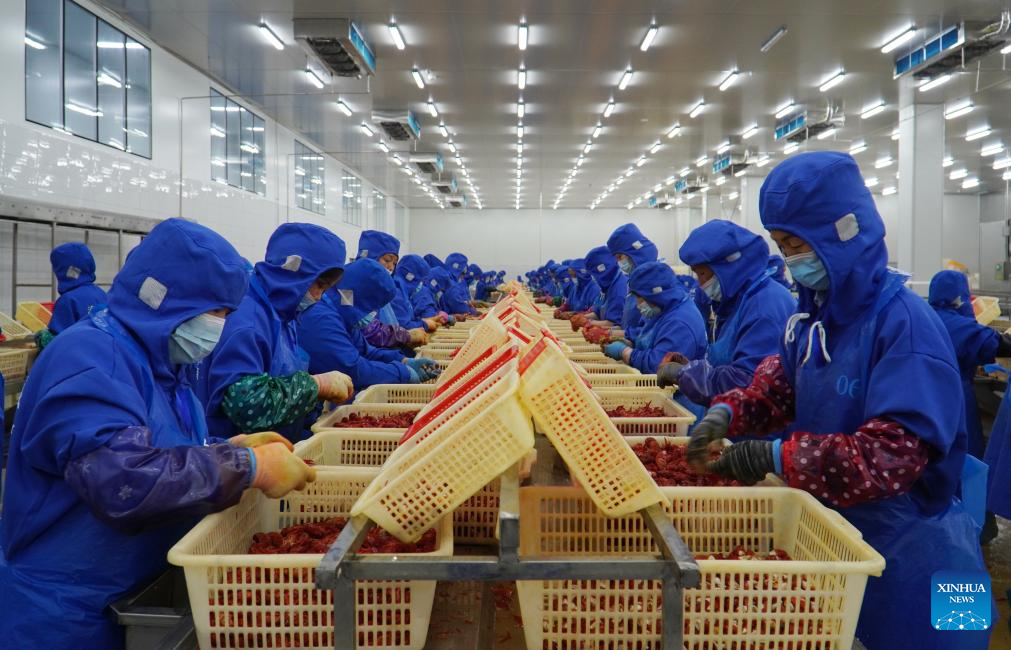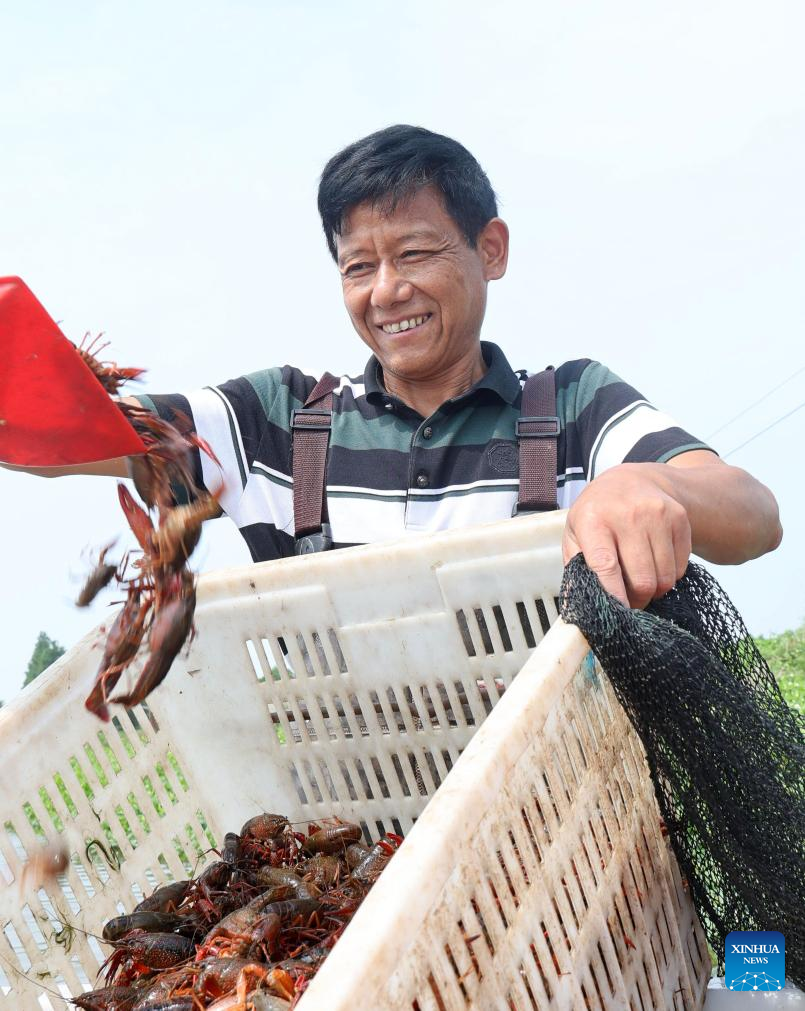
Staff members sort out crawfish at a food company in Nanxian County, central China's Hunan Province, on June 1, 2023. Summer brings the arrival of the crawfish season, turning Nanxian County into a bustling hub of activity. Situated in the hinterland of Dongting Lake, China's second-largest freshwater lake, Nanxian is known for its abundant water resources. It boasts an impressive average daily yield of 850 tonnes of crawfish.(Xinhua/Zhang Ge)
CHANGSHA, July 17 (Xinhua) -- Zhang Dehui springs out of bed at around 4 a.m. each morning, while the sky is still dark, swiftly dons his waterproof waders and heads for the crawfish fields.
Zhang is a rice and crawfish farmer from Nanxian County in central China's Hunan Province. He has devoted 136 mu (about 9.07 hectares) of land to a unique agricultural practice known as "crawfish-rice rotation," which involves planting rice during one season and rearing crawfish in fallow fields during the subsequent season.
"After midnight during the summer, temperatures tend to be relatively cool, making crawfish less irritable and easier to transport," Zhang said, adding that he has built a temporary shelter among the fields, allowing him to sleep there and check on the health of the animals.
"Every day, about 1,000 kilograms of crawfish are caught in my fields. By rotating crawfish and rice, I can make about 3,000 yuan (about 418 U.S. dollars) per mu annually in net income," said Zhang.
Summer brings the arrival of the crawfish season, turning Nanxian County into a bustling hub of activity. Situated in the hinterland of Dongting Lake, China's second-largest freshwater lake, Nanxian is known for its abundant water resources. It boasts an impressive average daily yield of 850 tonnes of crawfish.
The morning ushers in a flurry of activity in Nanxian's aquatic trade, with local farms taking their catch to market.
"The combination of fertile soil, abundant water, and suitable climate greatly contributes to the exceptional quality of our crawfish," said Peng Liu, the manager of a crawfish market. Dedicated to his work, Peng routinely greets the sunrise at the market, where he waits for deliveries from local farms.
"Upon receiving the crawfish from the farmers, we will carefully sort them and send the fresh ones to markets in Beijing, Shanghai and other cities across China, as well as to some local food processing plants," Peng said.
In Shunxiang Food Co., Ltd. in Nanxian County, the crawfish on the production line undergo a systematic sorting process using machines that categorize them based on their size. The crawfish then move through a series of automated or semi-automated procedures, such as ultrasonic cleaning, steaming, cooling, stir-frying and mixing with various seasonings. Finally, they are packaged into pre-prepared food products with different flavors.
"Our company's crawfish products include crawfish tails, whole crawfish and various other lines, with an annual export value expected to exceed 20 million U.S. dollars," said Liu Qunze, deputy general manager of the company.
Liu said that the company currently exports a wide range of crawfish products to over 40 countries and regions across Europe, the Americas and Southeast Asia. "We have developed a lineup of more than 200 different crawfish flavors to cater to diverse consumer preferences and eating habits worldwide."
In recent years, as part of the rural revitalization and modernization of agriculture initiatives, numerous Chinese counties have proactively focused on enhancing the quality of their agricultural products. They have also embarked on efforts to explore international markets, aiming to increase the global recognition and popularity of products like the crawfish farmed in Nanxian County.
After arriving in China to pursue her studies, Vietnamese student Tran Thu Trang was attracted by the rich and diverse Chinese food culture. From the renowned Peking duck to savory soup dumplings and spicy crawfish, she eagerly delved into exploring local food streets in every city she visited, immersing herself in regional snacks and culinary delights. She has also shared her culinary adventures with others, posting vlogs of her food excursions on social media platforms.
"The local specialities in each Chinese city provide insights into the region's climate, geography and human history. For instance, the crawfish we sampled in Hunan Province exemplifies the locals' love of spicy cuisine," she said, adding that understanding Chinese cities begins with the ability to appreciate their diverse food offerings. Enditem
(Wu Haowen also contributed to the story.)

Staff members operate at a workshop of a crawfish processing plant in Nanxian County, central China's Hunan Province, on June 1, 2023. Summer brings the arrival of the crawfish season, turning Nanxian County into a bustling hub of activity. Situated in the hinterland of Dongting Lake, China's second-largest freshwater lake, Nanxian is known for its abundant water resources. It boasts an impressive average daily yield of 850 tonnes of crawfish. (Xinhua/Zhang Ge)

Crawfish farmer Zhang Dehui harvests crawfish at his farm in Nanxian County, central China's Hunan Province, June 2, 2023. Summer brings the arrival of the crawfish season, turning Nanxian County into a bustling hub of activity. Situated in the hinterland of Dongting Lake, China's second-largest freshwater lake, Nanxian is known for its abundant water resources. It boasts an impressive average daily yield of 850 tonnes of crawfish. (Xinhua)



